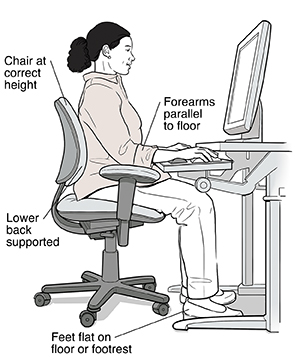Ergonomics: Adjust Your Chair
If you sit much of the day, your chair is your main support. A well-adjusted chair improves your circulation. It also helps prevent backaches and fatigue. You can increase your comfort by adjusting the chair's backrest position and height to fit your body.

Backrest
-
Sit at your workstation, leaning back slightly with your back firmly against the chair. The backrest should fit snugly against your lower back.
-
If it doesn't, adjust the backrest until your lower back is fully supported.
-
If you can't adjust the backrest, use a small, thin, firm pillow or rolled-up towel to support your lower back.
Chair height
Arm position
-
Place your fingers on the keyboard's middle row of letters. Your upper arms should hang comfortably at your sides. Your forearms should be parallel to the floor.
-
If they are not, adjust your chair height until your forearms are parallel to the floor.
Leg position
-
Keep your knees at or below the level of your hips. It may help to slide your feet forward until your knees are at a 90- to 110-degree angle. Your feet should rest firmly on the floor. There should be 1 to 2 inches of legroom between your lap and desk or keyboard tray.
-
If you have less than 2 inches of legroom, try to raise your desk or keyboard tray height.
-
If you can't adjust your chair height and your feet don't reach the floor, use something as a footrest. A box or binder can work. If you wear flat shoes, a level surface works best. If you wear heels, a slanted surface is better.
© 2000-2024 The StayWell Company, LLC. All rights reserved. This information is not intended as a substitute for professional medical care. Always follow your healthcare professional's instructions.